Without a doubt, Voile’s Switchback is my favorite telemark binding these days. It adorns three of the five pair of skis in my quiver — a pair of Karhu Guides that take a cruise through the backyard woods about 4 times a week, a pair of Atomic RT-86s for all manner of turns, and also a pair of RT-80s for spring tours when the 86ers are overkill. It has the most important features I require in a telebinding, and the ones it doesn’t have I don’t need (knock on wood).
If bindings were cars, the Switchback would be a Subaru for its all conditions driveability. In my house it is unanimous, the Subaru is a great winter vehicle — reliable and agile (summer too). There is constant jostling for the option to drive the Outback, especially when you consider the only other options in this household are a couple of Chivys. It isn’t the most powerful binding on the market, but it easily goes where others can’t. It doesn’t weigh a lot, and it isn’t the most expensive. It tracks superbly, uphill and downhill, and if you know how to drive ‘er, you can out maneuver higher-powered vehicles.Like a Suby, it’s a no frills ride, but well engineered. The toe plate is a hunk of bombproof, heat-treated stainless steel that wraps around your boot in a unitary design with brass bearings for the pivot. Tele resistance comes from Voile’s classic Hardwire cable assembly using solid cable bars and linear compression springs. The heel lever has been improved to be tougher and to latch with a more solid snap, whether on top of the heel step, or in the groove. It’s also easier to take off, especially with the tip of your ski pole.
Switchback has enough power to easily control the biggest ski I use (88mm waist) and then some, with a 3-buckle boot. I see plenty of folks using the Switchback on fatter skis, but they’re also pairing it with bigger boots. I think as soon as your ski gets wider than 100mm underfoot most skiers are better served with a more powerful binding. On the Hammerhead scale it comes in around HH#2.5ish, due largely to side routed cables that deliver a smooth, slow engagement of tele resistance. Fully loaded the binding feels like HH#3. In soft snow, the sensation is delightful and there’s no need for more. On firm snow, just drop low and there’s power enough to hold an edge as long as your head’s screwed on right.If earning your turns is a priority and dominates your ski time, fat rigs mean bigger boots and wider skins and more surface area for the snow collect and you end up hauling around over 10 pounds per foot in the skin track. Ugh. At only three pounds per pair the Switchback is the perfect antidote for the overweight heavy tele blues.
The mode switch is among the easiest to use. A thin, pear shaped loop of stainless steel sits at the front of the binding. Rotate it left to tour, right to lock the toe for turns. Just remember “righty tighty, lefty loosey,” like the convention for bolts. It is spring loaded, so it moves super easily with just a bit of rotational force and a smidgen of dexterity. Because the locking tangs are hidden inside the toe riser, they don’t ice up themselves, and tend to push off any that might build up on the horizontal locking bar at the back of the toe plate. It’s not quite as simple as the push button toggle of BD’s O1, but it’s more reliable since it rarely ices. It tends to play hide-n-seek under snow, making it hard to put your pole in the right place to switch it.In tour mode the toe plate rotates over 50° by itself. Stick a duckbill in it though and the range of motion is max 50°+. I say plus because you always get a degree or three more due to the bellows flex of a tele boot, but the toe plate itself only delivers 50.
Compared to other telemark bindings, it is the least prone to icing. After 200 tours and more than twice as many mode changes I’ve only had ice prevent switching back to turn mode three times; always in super sticky snow due to snow glamming on to my ski crampon post first, then growing so large it impeded closing the back of the toe plate. The locking tangs always worked so it is debateable that the binding itself iced up.
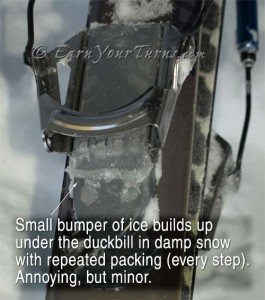
Nothing escapes the effects of icing, but the issue is minor with Switchback.
There’s only one thing I really don’t like on the Switchback — the climbing post. Specifically, they’re too dang hard to flip up. It’s not terrible, but compared to spring loaded heel risers like the original UTB heel, G3’s Ascent heel, or my fave, the HammerHeel, it takes a lot of effort.
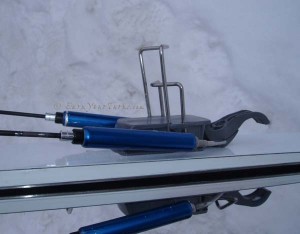
A nice base post for latch your heel lever under while transporting, and two heights of climbing peg. 45mm and 75mm.
These negatives are pretty minor. It’s my binding of choice. I’ve had the priviledge of being able to test all the telemark bindings on the market for the past twenty years and this is my fave, hands down. It isn’t the only binding I use, but the one I use most often.
If I skied more at a resort, with bigger boots and bigger skis, Switchback might not be my fave. For 80% backcountry and low- to mid-fat skis and boots, it’s the best there is.
For those who like the simplicity, reliability, and weight of the Switchback, but want more power, hold on ’til next season when the Switchback X2 will be available.
© 2011
Related Posts:
Review of Switchback X2
Face Off: Switchback X2 vs BD’s O1

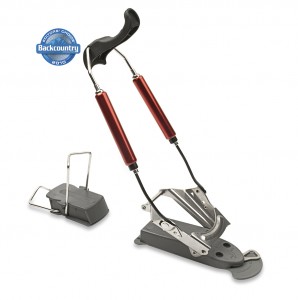
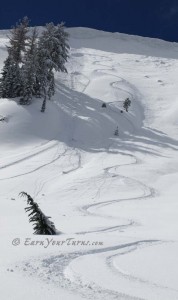
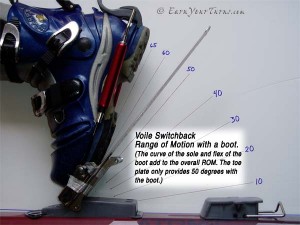
6 comments
4 pings
Skip to comment form
Craig –
Thanks for this. I love my SBs. I was so frustrated with targas, and 7Tm tours etc that I was about to make my own bindings before they came along. They deserve much more credit. In all the hype and non-sense about NTN, Switchbacks have not got the press they deserve. I convince a few skeptical friends to get them too, and their earlier derision is now praise and thanks for nudging them towards this binder.
I haven’t had any ice build up issues but we get pretty dry snow in the rockies.
With respect to the heel posts, I have a suggestion. I had a similar frustration with early G3 posts requiring way too much power to lift a few years ago. What I did then and repeated with my Switchback posts was this. Between use move the posts to mid-way between engaged and disengaged. Over a day or two it will loosen slightly widen the clamping force of the posts at on the heel piece. Now my SB heel riser posts flick up with only a modest tug from my ski pole handle. Given that you don’t want to loosen it too much start by doing this over night and increase until the posts loosen to the point you’re happy with.
Again, excellent to spotlight this great binding.
Joe
PS My usual dig incoming….Where is the Dostinator already?
Author
Nice tip on the climbing pegs.
re: Dostinator. In the shop already. It’s only been 10 years since I thought it up. Geez, Rotte took 8 years and they had a real machine shop. I did buy a grinder the other day though. Cut some pieces for the D3 and figured out the mode switch latch for D1 & D2.
Hi, Craig
I be new, here. My profile did not mention I am using the Switchbacks. One reason I am slow to learn is I am slow to spend what is to me a lot of money for gear. Gear does help those without talent, as I am also learning.
Never did have a nice pivoting toe before, when climbing. It really helps, which is no surprise to anyone on a real hill.
The climbing wires: I was looking them over when I first installed the bindings. I was struck by the difficulty in getting ’em up. (I am old, sounds too familiar). Anyway, the plastic over which the wires must pass is too much in the way. So I filed the plastic back about a half millimeter, each side. They work a bunch better. If you have not done this yet – – – – .
I don’t think we need to pray for snow, just sun and corn.
Onward
Warren
Author
When I first started lobbying for a free pivot on telemark bindings people always said, why?…we already have free heel. Yeah, but as you and everyone has finally realized, resistance is futile, freedom rules. There’s a huge difference between a highly resistive free heel and a frictionless free pivot.
Anyway, about those Voile climbing wires. Good point. Not sure what version of Switchback you’re skiing. If you have the gray heel throws, it’s probably a year or two old.
Am in the midst of testing the new Switchback X2 and must report that my criticism of Voile’s heel peg is out of date. They modified the heel post so that the wires pull up to about 25 degrees with almost no resistance, then there’s a bit of resistance to pull it all the way vertical and hold it there. I think it’s a solid improvement. Asked the factory about it and they said they changed the mold to make it easier to pull up. IOW – you weren’t the only one to think of shaving a few millimeters off the sides. Thanks for the tip.
Is the Garmont Energy too much boot for this binding?
Hard to say. A lot depends on the condition of the boot and your skiing style. In general, if the boot is well worn it won’t be too stiff for the Switchback. If it were hot off the presses, so to speak, it might be. YMMV.
[…] Ascent users will appreciate the improvement to the mode switch which is activated, just like BD’s O1, by pressing a toggle switch at the front of the binding with a ski pole. Except the Enzo switch takes noticeably less pressure to activate than the O1. It is arguably the easiest mode switch to operate of any telemark binding. Like the O1, or Switchback, you can flip it back to turn mode with your heel lifted and the toe plate will lock when you step down. Two tangs that extend from the rear of the toe housing hold down a bar at the back of the toe plate, just like the Voile Switchback. […]
[…] you love your current 75mm boots stick with 75mm options like O1, Axl, Enzo, RT Spike, Switchback or the X2 version, and if you must have a safety release, 7tm Power […]
[…] Voile Switchback […]
[…] Switchback review […]